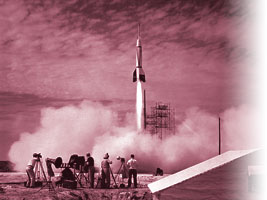In order to fly properly a rocket MUST be stable.
Technically, a rocket must have it's center of pressure (Cp)
behind the center of gravity (Cg) in order to fly without
tumbling. A simple way to think about it is if you consider
the design of a dart from a darts game. It has a heavy nose
(the barrel and tip) and a light tail with the 'fins'
(flight). A rocket needs to be designed in a similar way to
be stable.
For better explanations and more details on rocket
stability here are some good references:
For even more detailed explanations, don't hesitate to
use your favourite search engine.
Here are some common rocket flight patterns, their likely
causes and suggestions on how to correct them. Of course a
typical rocket may be influenced by a number of factors
simultaneously. After fixing one, you may need to fix
another.
| Flight path |
Probable
Cause |
Potential
Remedy |
| Rocket
tumbles end over end soon after launch
 |
Rocket is unstable
|
Make the rocket stable by doing one or more of
the following:
- Add weight to the nose [1]
- Increase the fin size
- Lengthen rocket
- Move the fins further back
- Attach fins properly. The fins should be as rigid as possible. They
should not flop around.
- Make the fins from a lighter material
|
| |
| Rocket flies straight but spins around
its axis
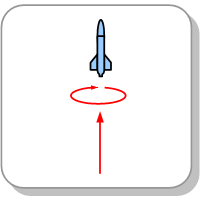 |
Misaligned fins, one or more fins are not
aligned with the rocket axis |
Use fin alignment jig to ensure proper
orientation. |
| Warped fins |
Use materials that don't warp when exposed to
moisture or heat. |
| Unevenly sized or
irregularly shaped fins |
Make fins using a template to ensure same size and
shape of all fins |
| Fins unevenly spaced around the rocket body |
Accurately measure the spacing of your fins around
the rocket. Use a fin alignment jig. |
| Asymmetric protrusions from rocket body such as
camera housings or components of recovery systems
such as air flaps. |
Try to make any protrusions symmetrical. A
protrusion may cause a rocket to both spin and fly
in an arc. |
| |
| Rocket flies in an arc
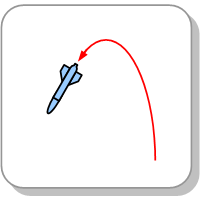 |
Cross wind
|
Fly on less windy days or wait for calmer
conditions between wind gusts. Rocket will
'weathercock' into the wind if this is the cause.
|
| Axially unbalanced |
Balance internal components in the rocket. The
recovery and payload components should be spread
around the axis of the rocket to keep it balanced.
[2] |
Misaligned nozzle/ obstruction in nozzle
|
Ensure the nozzle is aligned with the rocket
axis. [3]
|
| Uneven airflow over rocket due to protrusions such
as camera housings, air flaps etc. |
Make protrusions from the rocket symmetrical and
evenly spaced around the rocket. |
| Rocket body is bent |
Practice good construction techniques to prevent
building a bent rocket. The rocket may also bend due
to pressure. |
| |
| Rocket flies in an arc but when water runs out
flies straight
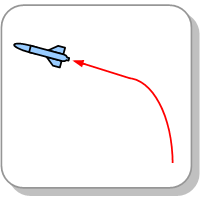 |
Rocket is marginally stable |
Improve rocket stability. Rocket is marginally
stable during the water phase. |
| Nozzle too small |
Increase the nozzle size if possible. |
| Too much water |
Reduce the amount of water in the rocket. |
| Not enough pressure |
If it is safe to do
so, increase the pressure. |
| |
| Rocket performs an 'S' or fishtail in flight
 |
Rocket is marginally stable |
Rocket may be marginally stable until water
runs out. Try to improve stability. |
| Water slosh due to the
rocket not pointed vertically on the launch pad |
Water may be sloshing in the rocket as its
launched causing a sideways motion, and then swings
back when the internal wave reflects from the other
side of the rocket. This can be caused when the
launcher is not levelled properly and the water is
sitting against the side of the rocket. |
| |
| Rocket flies straight normally but veers off
course at launch
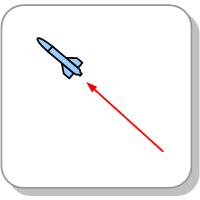 |
No or too short guide rail |
Increase the length of the guide rail(s). This
will allow the rocket to reach stable flight sooner
while pointing in the right direction. |
| Cross wind |
Wait for calmer conditions. |
| Unstable launcher |
Secure launcher to the ground. The launcher may
move when the launch string is pulled inducing a
pitching motion on the rocket as it releases. |
| Low takeoff acceleration potentially due to: |
|
| Too much water |
Reduce the amount of water in the rocket. |
| Not enough pressure |
Increase the pressure but stay within safe limits. |
| Nozzle too small |
Increase size of nozzle if possible. |
| Rocket is too heavy |
Reduce weight of rocket |
| |
| Rocket flies straight for first part of flight
but tips over soon after
 |
Loss of power due to blow through
effect
|
This flight path is more obscure but has been
observed in rockets that use narrow Robinson
couplings and large nozzles. In this instance some
of the air escapes leaving some water in the rocket. Try to match the nozzle size to the size of the
Robinson couplings.
Use a baffle over the Robinson coupling to prevent
blow through. |
| Broken fin(s) |
A fin may come off during launch or become loose
resulting in loss of stability. |


